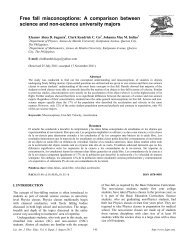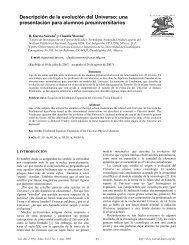Traveling along a zipline
Traveling along a zipline
Traveling along a zipline
You also want an ePaper? Increase the reach of your titles
YUMPU automatically turns print PDFs into web optimized ePapers that Google loves.
y<br />
2 2<br />
1 a 1 ( a bf )<br />
b<br />
.<br />
(10)<br />
Again, with no rider on the line, put f<br />
obtain<br />
1 and Y Y / L to<br />
Y<br />
2 2<br />
0 0 0<br />
1 a 1 ( a b )<br />
b<br />
0<br />
.<br />
(11)<br />
Equations (9) and (11) cannot be analytically inverted to find<br />
a 0 and b 0 in terms of X and Y . So rather than spelling out<br />
the solution to the problem in terms of the position ( XY , ) of<br />
the right-hand end of the cable, it makes more sense to write<br />
it in terms of the angles i and f that the cable makes at its<br />
two ends without a rider. 2 Recalling the definition of a and<br />
solving Eq. (4) for b, one can write<br />
a and b 0 tan i tan f . (12)<br />
0 tan i<br />
Then the (normalized) position of the right end of the cable<br />
can be determined from Eqs. (9) and (11). That position<br />
remains fixed as the rider mounts the cable, as does the<br />
length of the cable. But the values of a and b change and are<br />
no longer equal to a 0 and b 0 , because the shape (and hence<br />
the two end angles) of the cable change with a rider present.<br />
In fact, it is clear that even for a fixed (nonzero) rider mass,<br />
the values of these two parameters vary as the person<br />
changes position f <strong>along</strong> the <strong>zipline</strong>. So the problem now<br />
becomes one of finding the values of a and b for a given<br />
rider position f and mass M (expressed in normalized form as<br />
M / m relative to the cable’s mass). The key to solving<br />
this problem is that Eqs. (8) and (10) give the position ( xy , )<br />
of the cable at the rider’s position relative to the left-hand<br />
end of the cable (in terms of the unknowns a and b). Similar<br />
equations (in terms of the same two unknowns) give the<br />
position ( x, y ) of the right-hand end of the cable relative to<br />
the rider. 3 By imposing the constraints x x X and<br />
y y Y , two equations are obtained in the two unknowns<br />
and a root-finding algorithm can be used to solve for a and b.<br />
The first step is to find the angle 0 of the cable<br />
immediately to the right of the rider. For this purpose,<br />
consider a segment of the cable that starts at the origin and<br />
just barely extends beyond the rider’s point of attachment.<br />
Equation (3) can be modified in this case by adding the<br />
rider’s weight Mg to the right-hand side,<br />
T0 sin 0 T0 sin 0 mgf Mg , (13)<br />
<strong>Traveling</strong> <strong>along</strong> a <strong>zipline</strong><br />
where became the rider’s position fL, angle became<br />
0 , and likewise for the tension T. Again divide this<br />
equation by Eq. (2) to get<br />
tan 0 tan 0 bf b .<br />
(14)<br />
Consequently the parameter corresponding to a for the righthand<br />
segment of the cable is<br />
a a bf b .<br />
(15)<br />
Unlike Eq. (3), however, Eq. (1) remains valid even when<br />
the point ( xy , ) in Fig. 1 is moved to the right of the rider,<br />
because the rider’s gravitational force does not have an x<br />
component. Thus K has the same value on the left-hand and<br />
right-hand segments of the <strong>zipline</strong>. Therefore the parameter<br />
corresponding to b for the right-hand segment is unchanged,<br />
b b. Finally, the sum of the lengths of the left-hand and<br />
right-hand segments of the cable must be L, and thus the<br />
parameter corresponding to f for the right-hand segment<br />
must be f 1 f . Now simply substitute these values of<br />
a , b , and f in place of a, b, and f in Eqs. (8) and (10) to<br />
get<br />
and<br />
x<br />
y<br />
2<br />
1 a bf b 1 ( a bf b )<br />
ln ,<br />
b 2<br />
a b b 1 ( a b b)<br />
2 2<br />
1 ( a bf b ) 1 ( a b b)<br />
b<br />
.<br />
(16)<br />
(17)<br />
The sum of Eqs. (8) and (16) is set equal to Eq. (9), and the<br />
sum of Eqs. (10) and (17) to Eq. (11) and the command<br />
―FindRoot‖ in Mathematica is used to solve for a and b for<br />
given values of and f. Figure 2 plots the results for equal<br />
to 0, 0.1, 0.5, 1, 2, and ∞ with f varying from 0 to 1 in steps<br />
of 0.01. As explained next, these trajectories interpolate<br />
between a catenary and an ellipse as increases in value.<br />
2<br />
Note that the angle anywhere <strong>along</strong> the cable (including its two ends),<br />
with or without a (finite-mass) rider, is limited to the range 90 90<br />
since the line can never become vertical according to Eq. (2). Within that<br />
range, tan is always finite and is a single-valued function of .<br />
FIGURE 2. Trajectories followed by the rider through space for six<br />
3<br />
Hereafter, primes are consistently used to indicate parameters of the cable different values of (ratio of the masses of the rider and of the<br />
segment to the right of the rider that correspond to the unprimed parameters<br />
of the cable segment to his left.<br />
<strong>zipline</strong>) indicated in the legend, for parameters i 45 ,<br />
Lat. Am. J. Phys. Educ. Vol. 5, No. 1, March 2011 7 http://www.lajpe.org


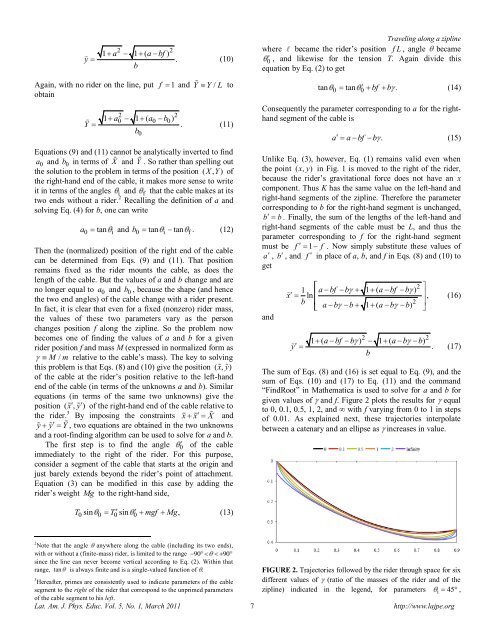
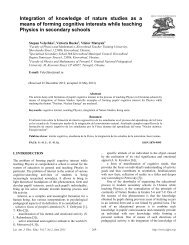
![Diversas formas de visualizar estados en un sistema cuántico [PDF]](https://img.yumpu.com/51151303/1/190x245/diversas-formas-de-visualizar-estados-en-un-sistema-cuantico-pdf.jpg?quality=85)

![Precession and nutation visualized [PDF]](https://img.yumpu.com/50786044/1/190x245/precession-and-nutation-visualized-pdf.jpg?quality=85)
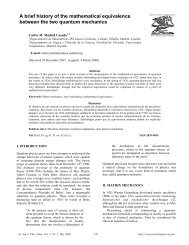
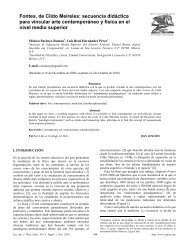
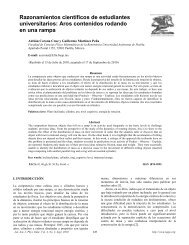

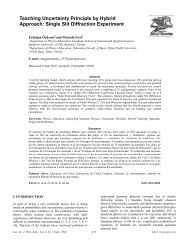
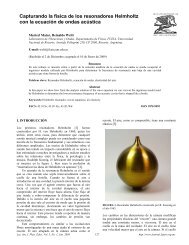
![Index [PDF] - Latin-American Journal of Physics Education](https://img.yumpu.com/47984121/1/190x245/index-pdf-latin-american-journal-of-physics-education.jpg?quality=85)
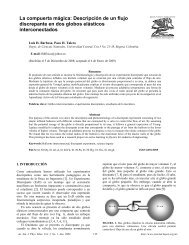
![Flujo de agua en botellas como experimento didáctico [PDF]](https://img.yumpu.com/43536300/1/190x245/flujo-de-agua-en-botellas-como-experimento-didactico-pdf.jpg?quality=85)
